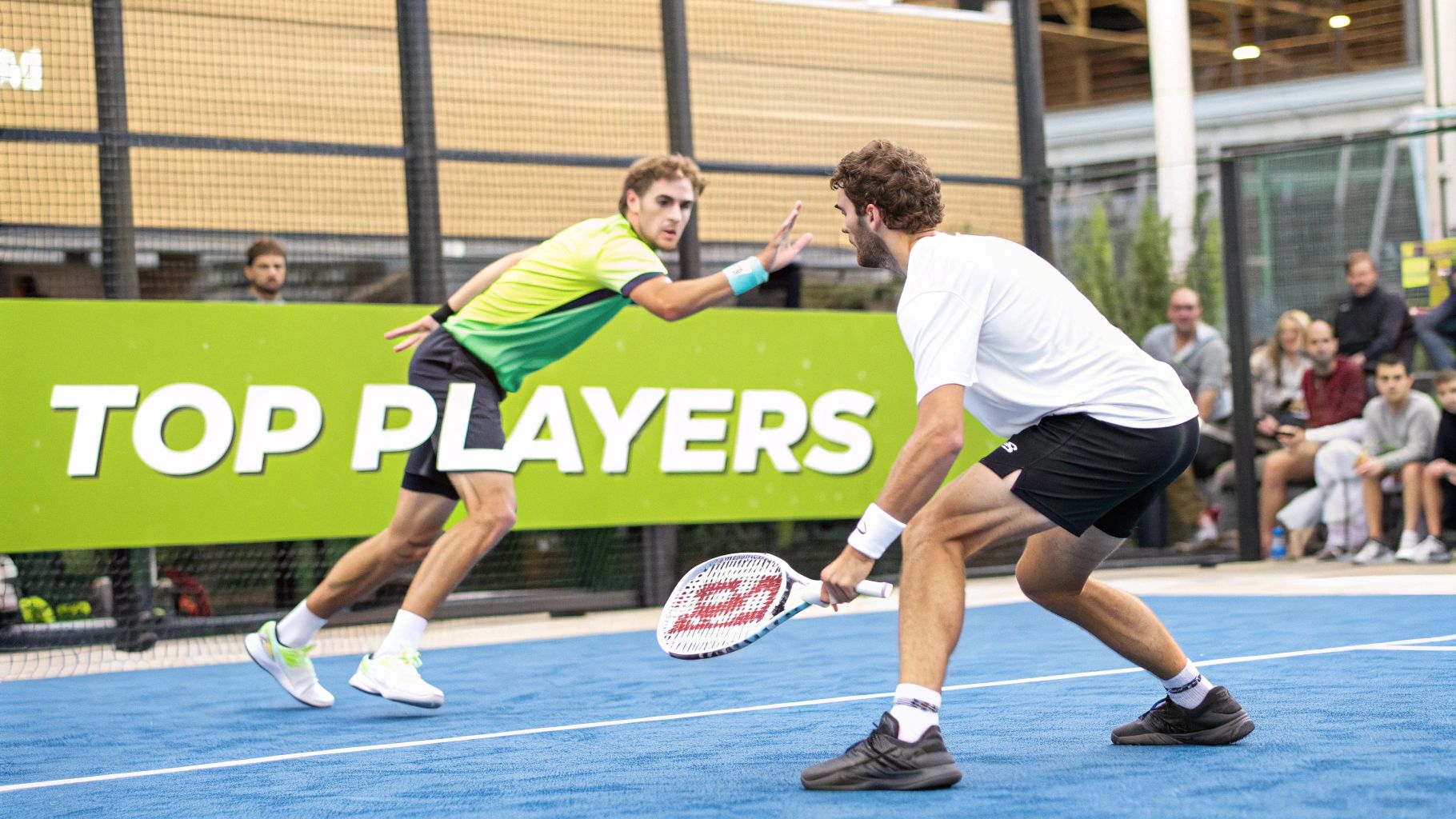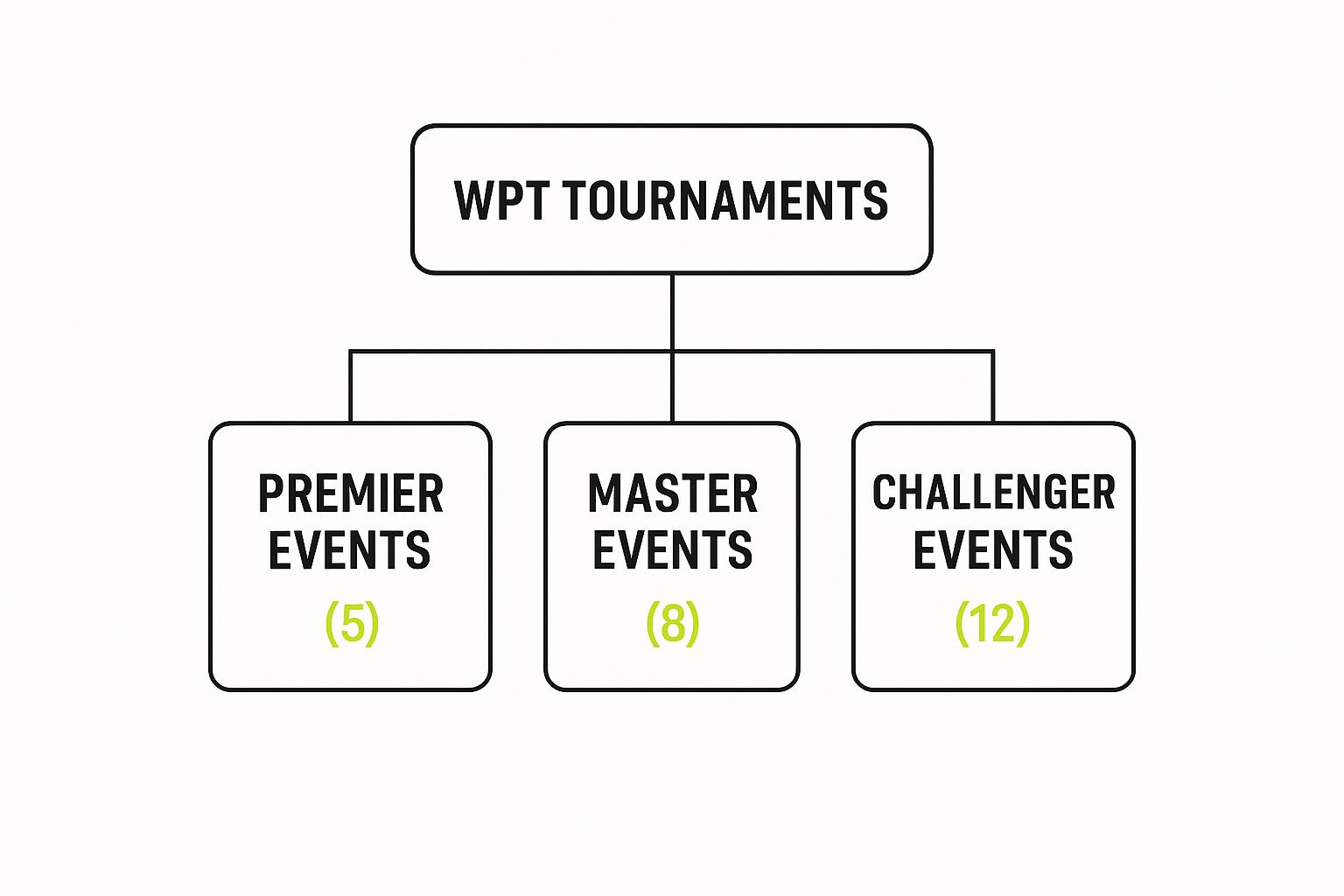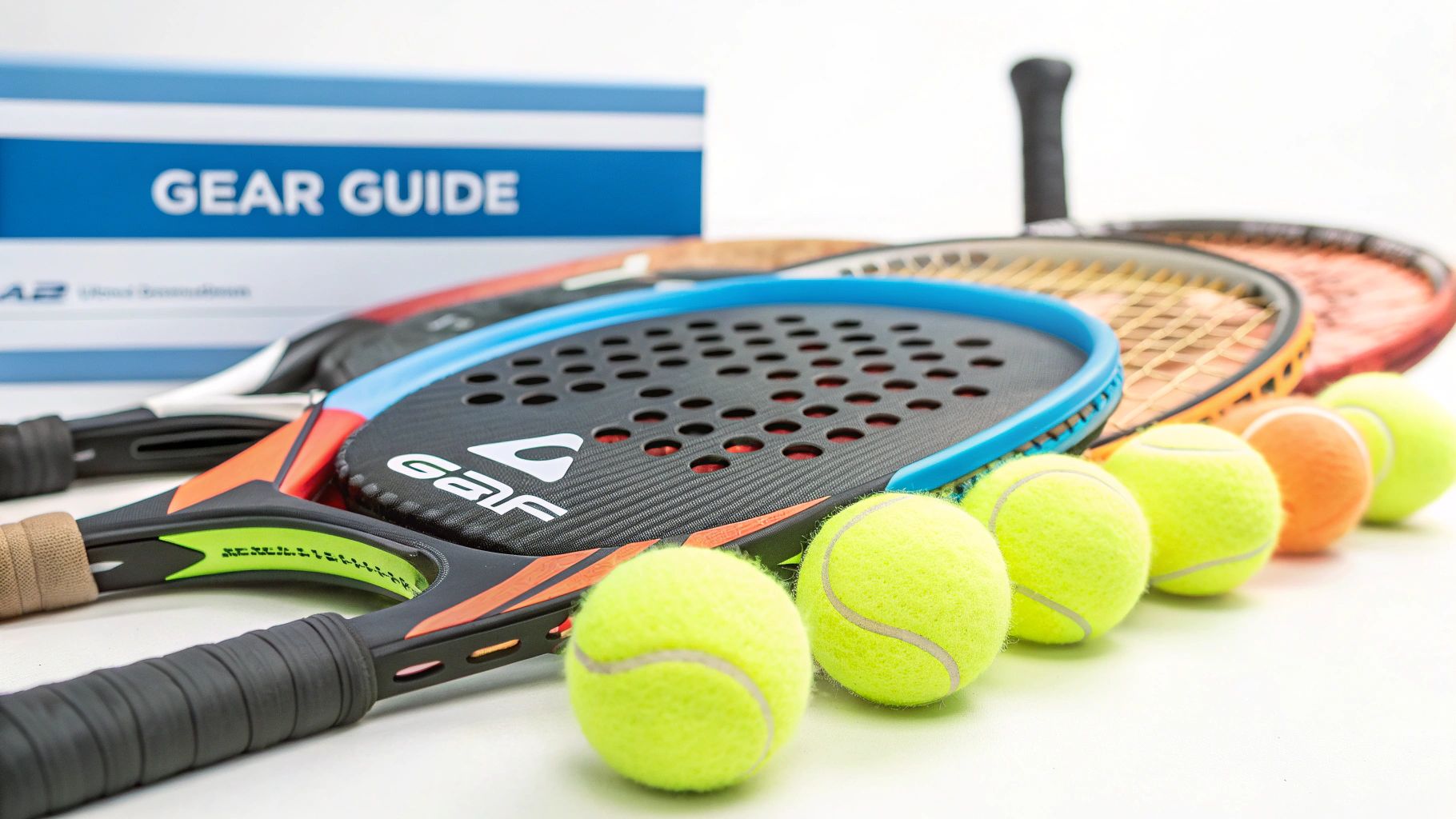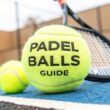If you're getting into padel, you'll hear one name over and over again: the World Padel Tour (WPT). This is the premier global circuit for professional padel, the biggest stage where the sport's elite battle it out.
Think of it as padel’s equivalent of the ATP Tour in tennis. It's the absolute pinnacle of the sport, the place where careers are made, champions are crowned, and a massive international audience tunes in to watch. The tour is essentially a season-long series of high-stakes tournaments hosted all over the globe.
What Exactly Is the World Padel Tour

At its heart, the World Padel Tour is the organization that structures, promotes, and runs the highest level of professional padel. Before the WPT came along, the pro scene was a bit scattered. The tour unified everything, creating one cohesive season that travels from continent to continent, showcasing some truly breathtaking athleticism.

Buy the best padel gear to level up your next game!
CHECK OUT this deal from Padel Market!Get ready to take your game to the next level with the latest padel gear from Padel Market! Fast EU and Worldwide Shipping
This isn't just a random collection of events. It's a meticulously planned global journey where every single match matters. Players are constantly fighting for ranking points, prize money, and prestige, all building towards the ultimate goal: being crowned the world's best.
Before we dive deep into its history and structure, here’s a quick snapshot of what makes the WPT tick.
World Padel Tour at a Glance
This table gives you a quick look at the WPT's core components, providing a high-level overview before we explore each element in more detail.
| Feature | Description |
|---|---|
| Circuit Type | The official global professional tour for padel, hosting events worldwide. |
| Season Duration | Typically runs from February to December each year. |
| Competition | Features the world's top-ranked male and female players competing in doubles pairs. |
| Key Goal | To accumulate ranking points throughout the season to qualify for the year-end Master Final. |
| Global Reach | Tournaments are held in numerous countries across Europe, the Americas, and the Middle East. |
| Tournament Tiers | Events are categorized into tiers (e.g., Master, Open) offering different levels of points and prize money. |
This structure is what gives the professional season its narrative and excitement.
The Purpose of the Tour
The WPT was created to professionalize the sport and take it to the next level. It gave padel a unified platform that could attract major sponsors, secure media coverage, and build a dedicated fanbase. In short, it helped transform padel from a beloved niche sport into a mainstream global spectacle.
Its mission really breaks down into a few key areas:
- Showcasing Elite Talent: It provides a consistent stage for the world's best players to go head-to-head.
- Global Expansion: The tour actively brings top-tier padel to new countries, fueling the sport’s incredible international growth.
- Standardizing Competition: It establishes the official rules, tournament levels, and a definitive ranking system that governs the professional game.
- Fan Engagement: Through high-quality broadcasts and slick digital content, the WPT makes pro padel accessible and exciting for viewers everywhere.
The World Padel Tour acts as the engine of professional padel, creating a structured, competitive environment that not only determines the world champions but also inspires millions to pick up a racket.
A Glimpse into the Season
Think of the WPT season like a Formula 1 Grand Prix. It typically runs from February to December, with a calendar packed with tournaments held in iconic cities around the world. These events vary in size and importance, with players battling through tough qualifying rounds and main draws to reach the finals.
The season is a true test of endurance, skill, and—most importantly in padel—partnership chemistry. Teams that perform consistently well rack up points and climb the official rankings.
This whole year-long journey culminates in the Master Final, a prestigious championship where only the top-ranked pairs get an invitation to compete for the ultimate title. It’s the Super Bowl of padel, and it’s what every player is working towards all year.
The Tour's Rise to Global Prominence

The World Padel Tour didn't just pop up overnight. It was born in 2013 out of a very real need to bring professional padel together under one roof. Before the WPT, the pro scene was a bit messy and fragmented, built on the old Padel Pro Tour. The mission was simple but ambitious: create a single, powerful, and globally recognized league for the sport.
This new structure pulled all the best players, tournaments, and commercial partners into one cohesive unit. Imagine a bunch of small, regional leagues finally merging to create a powerhouse like the NBA or the NFL. That move was the spark that turned padel from a regional favorite into the international sensation it is today.
By creating a unified tour, the WPT became a stable, marketable product. Suddenly, it could attract bigger sponsors and lock in international broadcast deals. Fans finally had a clear, season-long story to follow, with all roads leading to a definitive championship. This strategic unification was the first major step on an incredible journey.
From Spanish Heartland to Global Stage
In the beginning, the World Padel Tour was all about Spain. It's the sport's adopted home, so naturally, most of the tournaments and top-ranked players were either Spanish or Argentinian. But for the tour to have a real future, it had to break out of its comfort zone.
The expansion was slow and deliberate. The WPT started by hosting exhibition matches in new European markets like Portugal, France, and Italy. When those went well, they followed up with official tournaments. Each successful event planted a seed, sparking interest among local players, media, and investors.

Buy the best padel gear to level up your next game!
CHECK OUT this deal from Padel Market!Get ready to take your game to the next level with the latest padel gear from Padel Market! Fast EU and Worldwide Shipping
The results were stunning. Soon, we were seeing packed stadiums in cities like Rome, Paris, and Stockholm. It was clear the appetite for elite padel was massive and totally untapped. That success in Europe gave them the confidence they needed for an even bigger international push.
The WPT's genius was realizing that to grow the tour, they first had to grow the sport itself. By taking the world's best players to new countries, they triggered an explosion of interest and participation at the grassroots level.
This global expansion became the tour's calling card. Before long, the WPT calendar had stops across Latin America and the Middle East, making it a truly worldwide circuit. The growth in both the number and variety of locations has been nothing short of impressive.
The tour's footprint has grown massively since its 2013 launch. From 2019 to 2024, the number of top-tier tournaments jumped significantly, proving the sport's rapid growth. While Spain is still a major hub, countries like Italy, Argentina, and the United Arab Emirates are now regular, enthusiastic hosts on the calendar. You can dive deeper into the stats and see this growth for yourself in the 2024 World Padel Report.
Creating Superstars and Unforgettable Rivalries
At the end of the day, a sports league is only as good as its stars. The WPT understood this perfectly and went to work building the profiles of its top players, turning them from great athletes into household names. The tour’s marketing and high-quality broadcasts were laser-focused on the human drama: the intense rivalries, the unbreakable partnerships, and the big personalities on the court.
This storytelling gave fans heroes to cheer for and rivalries to get invested in. Legendary pairings became famous, and their epic finals became must-see TV.
Here are a few ways the WPT made its players shine:
- Signature Broadcasts: Crisp, high-definition live streams with expert commentary made the game exciting and easy for anyone to follow.
- Digital Content: They pushed out tons of behind-the-scenes footage, player interviews, and slick highlight reels on social media, letting fans feel connected to the athletes.
- Rivalry Narratives: The tour played up the history between top teams, building incredible hype for potential finals matchups.
By putting the players front and center, the World Padel Tour gave fans a reason to tune in beyond just the sport itself. They tuned in for the drama and the personalities. If you want to keep up with the latest action, you might be interested in our dedicated section on upcoming padel tournaments. This player-focused approach is what cemented the WPT's place at the top, captivating a massive global audience and setting the stage for padel's big break into the mainstream.
How the Tournament Structure Works
If you're new to the World Padel Tour, the best way to think about the season is like a giant, year-long pyramid. The base is packed with tournaments where tons of pairs compete. As you climb higher, the events get more exclusive, the stakes skyrocket, and only the absolute cream of the crop remains. This entire setup is built to reward consistency and tell a story that culminates in a massive end-of-year showdown.
Every single tournament on the calendar offers two things every player desperately wants: prize money and ranking points. It's simple, really—the higher a tournament sits on that pyramid, the more of each is on the table. This tiered system makes every match count, as players are always scrapping to climb to that next level of competition.
This hierarchy creates a natural progression for players. You'll see up-and-coming talents grinding it out in the lower-tier events, hoping to scoop up enough points to get into the main draws of the bigger tournaments. Meanwhile, the established stars are laser-focused on bagging the most prestigious titles to cement their place at the very top.
The Foundation: Open Tournaments
At the very bottom of the pyramid, forming its wide base, are the Open events. These are the workhorse tournaments of the WPT calendar, the most frequent stops on the tour, and the absolute backbone of the professional season. They're the main battleground where a whole range of players—from gritty veterans to the next big thing—can earn those vital ranking points and prize money.
A typical Open features a big main draw, but before that, there are grueling qualification rounds. This is where the lower-ranked pairs fight tooth and nail for a shot to play against the world's best. Winning an Open is a huge deal and a critical milestone for any pair that dreams of being champions.
The Big Leagues: Master Tournaments
Take one step up from the Opens, and you're in Master territory. Think of these as the majors of the World Padel Tour, the equivalent of Grand Slams in tennis. There are only a handful of Master events each year, which makes every single one a hugely anticipated spectacle that pulls in massive crowds and gets fans buzzing all over the world.
These are the events where you'll see the most ferocious competition. All the top-ranked pairs are there, and they're all fighting for one of the season's most sought-after trophies. The draws are absolutely stacked from the very first round, which means you're guaranteed blockbuster matches all week long.

To really get a handle on the WPT season, it helps to see how these tournaments stack up against each other. Each tier has its own feel, its own stakes, and its own role to play in the year-long race to the top.
Here's a quick breakdown to help you follow the action like a pro.
Understanding the WPT Tournament Tiers
| Tournament Tier | Key Characteristics | Ranking Points for Winners | Typical Participants |
|---|---|---|---|
| Open | The most common WPT event. The backbone of the tour with large draws and qualification rounds. | 1000 | A mix of top-ranked players and rising stars fighting to break through. |
| Master | The most prestigious events, similar to tennis Grand Slams. Fewer on the calendar, with bigger stadiums and more hype. | 2000 | All the elite, top-ranked pairs in the world. Competition is fierce from round one. |
| Master Final | The season-ending finale. An exclusive, invitation-only tournament for the year's best performers. | 1500 | Only the top 16 players of the season (the top 8 male and female pairs). The absolute best of the best. |
As you can see, winning a Master event gives a massive points boost, but the exclusive Master Final is the ultimate prize that proves who truly dominated the season.
The Pinnacle: The Master Final
Right at the very top of the pyramid, the final peak, is the Master Final. This is it. The ultimate showdown, the grand finale of the entire World Padel Tour season. It's held every December and is an exclusive, invitation-only party for the year's most dominant players.
You can't just sign up for this one. Only the top 16 players (that’s eight male pairs and eight female pairs) in the "Race" standings—which only counts points earned during that specific season—get the golden ticket. This makes for an unbelievably elite field packed with only the best of the best.
Even the format is special. Instead of a straight knockout bracket, it usually kicks off with a round-robin group stage. This is awesome for fans because it guarantees you get to see every top pair play multiple times before the high-stakes knockout semis and final. Winning the Master Final is the ultimate honor, crowning a pair as the undisputed champions of the season.
Making Sense of the Ranking System
The ranking system is the heart of all the drama on the World Padel Tour. You can think of it like a stock market for players—their "value," represented by points, goes up or down based on how they perform at each tournament. It's a relentless system that shapes everything from a player’s reputation to their paycheck.
This isn't just some simple leaderboard. It's a live, rolling 12-month calendar. Players are constantly under pressure to defend the points they earned at the same tournament last year. If a player had a huge win last March, they've got to deliver again this March, or they'll see their ranking take a serious hit. This structure is exactly why only the most consistent pairs manage to stay at the very top.
Every single match suddenly becomes a high-stakes opportunity. A deep run in a Master event can send a pair flying up the standings, but an unexpected early exit can be absolutely devastating. That constant pressure is what keeps fans glued to the tour week after week.
The Mechanics of Earning Points
So, how do players actually get their hands on these critical points? The formula is pretty simple: the deeper a pair goes in a tournament, the more points they collect. But here's the catch—not all points are created equal. The tournament's tier, which we covered earlier, makes a huge difference.
- Master Events: These are the big kahunas of the tour, offering the biggest prize of all: 2000 points for the winners. A victory here can completely shake up the top of the rankings.
- Open Events: These are the most common tournaments on the calendar. They provide a steady stream of chances to earn points (1000 points for the champs) and are absolutely essential for holding onto a high rank.
- Master Final: This one is exclusive, but winning the season-ender also carries a massive points reward (1500 points), cementing a pair's legacy as the best of the year.
This tiered structure creates a crystal-clear incentive: if you want a shot at that number one spot, you have to show up and perform at the biggest events.
Here's a peek at the official World Padel Tour rankings page, which gets a fresh update every week.
This snapshot gives you the current pecking order, with each player's points total showing their performance over the last 52 weeks. It's the official scoreboard that dictates everything from tournament entry to seedings.
Why Rankings Are Everything
A player's rank isn't just about bragging rights; it's the master key that unlocks their entire season. It has a direct impact on their path through every single tournament.
A high ranking is a player's most valuable asset on the World Padel Tour. It grants them direct entry into the most prestigious tournaments, favorable seedings that help them avoid top opponents early on, and ultimately, a shot at the coveted Master Final.
For example, the top-ranked pairs get seeded. This means they're strategically placed in the tournament draw to avoid facing each other in the early rounds—a massive advantage. A high ranking also lets players bypass the grueling qualification rounds and jump straight into the main draw, saving precious energy for the tougher matches ahead. To see exactly how these standings change from week to week, you can check out our complete guide to the official padel ranking systems.
Ultimately, this whole system is designed to funnel down to one single, glorious goal: qualifying for the Master Final. Only the top eight pairs at the end of the year get that coveted invitation. It’s a year-long battle where every single point—earned and defended—can be the difference between joining the elite and watching from the sidelines.
Meet the Legends and Rising Stars

Any pro tour is only as good as its players—the icons who leave you speechless and the young guns who bring a whole new level of energy. The World Padel Tour is no exception. It was built on the backs of legends whose rivalries and incredible skills literally defined the modern game. These are the guys who made professional padel a global spectacle.
But the game never stands still. A new wave of talent is crashing onto the scene, armed with explosive power, shots nobody has seen before, and zero fear. They aren't just showing up to play; they're here to knock the legends off their thrones and build their own legacies. This is the human drama that makes every single tournament an absolute nail-biter.
The Icons Who Built the Game
When you talk about the legends of the World Padel Tour, one name towers above the rest: Fernando Belasteguín. Known to everyone as "Bela," he is the sport's undisputed G.O.A.T. His strategic mind, ridiculous consistency, and an insane will to win set the bar for what it means to be a champion.
Belasteguín is a giant of padel history, holding the world number 1 spot longer than anyone else. Since the tour kicked off in 2013, only a handful of players have ever reached that peak. But Bela, alongside his legendary partner Juan Martín Díaz, owned that top spot from 2013 to 2018. They were so dominant in those early years that they were practically unbeatable, shaping the entire tour's competitive identity. You can learn more about the exclusive club of players who have reached the top of the World Padel Tour rankings.
Alongside Bela, a few other names have become padel royalty:
- Juan Martín Díaz: Known as "the magician" for his jaw-dropping creativity and impossible shots. His partnership with Belasteguín is one of the most successful in all of sports history.
- Paquito Navarro: A fiery, charismatic showman from Spain. Paquito is all about aggressive, powerful smashes and brings a passion to the court that makes him a fan favorite year after year.
- Sanyo Gutiérrez: Another "magician," Sanyo is famous for his incredible touch, tactical brilliance, and knack for finding creative ways out of tough spots.
These players didn't just win tournaments; they gave the tour its soul with their unique styles and unforgettable on-court battles.
The New Generation of Stars
The old guard of the World Padel Tour is now facing its biggest threat: a generation of young, hungry players who are rewriting the rules. These rising stars grew up watching the legends, and they've mixed that inspiration with modern power and athleticism to create a whole new brand of padel.
Leading this charge are players like Agustín Tapia and Arturo Coello. Tapia is a human highlight reel, famous for his insane aerial game and mind-bending creativity. Coello, on the other hand, is just a force of nature—pure power and athleticism that overwhelms opponents at the net.
The current era of the World Padel Tour is all about this clash of generations. It’s a fascinating chess match between the tactical mastery of the old school and the raw, explosive power of the new kids on the block.
This same generational shift is happening in the women's game. For years, legends like the Sánchez Alayeto twins, Mapi and Majo, ran the show. Now, dynamic young players like Bea González and Marta Ortega are taking over with their incredible speed, aggression, and all-court game.
Key Rivalries to Follow
The tension between these different generations and playing styles has cooked up some of the most exciting rivalries on tour. Watching these pairs go head-to-head is where the real magic happens.
- Veterans vs. Newcomers: Any match that pits a legend like Belasteguín against a young phenom like Tapia is must-see TV. It’s the ultimate battle of experience versus raw athleticism.
- Power vs. Finesse: A matchup between a power duo like Coello and Tapia against a tactical team like Sanyo Gutiérrez and his partner really shows off the strategic depth of the sport.
- Top-Ranked Showdowns: In the women's draw, the battles between top pairs like Ari Sánchez/Paula Josemaría and Gemma Triay/Marta Ortega are guaranteed to be high-quality, edge-of-your-seat padel.
These rivalries are what drive the tour's story forward, giving fans a reason to get invested in every point. The mix of iconic legends and fearless rising stars is exactly what keeps the World Padel Tour an electrifying show, tournament after tournament.
How You Can Watch The Action
Ready to dive into the high-speed world of professional padel? Following the World Padel Tour is easier than ever, with a mix of dedicated streaming services and global broadcast partners bringing every smash and bandeja right to your screen.
The first stop for any serious fan has to be WorldPadelTourTV, the tour's official streaming platform. It's a total game-changer, offering free live coverage of tournaments from the very first rounds all the way to the finals. Think of it as your all-access pass to the action, often with English commentary and feeds from multiple courts.
Your Streaming and Broadcast Options
Beyond the official app, the World Padel Tour has teamed up with plenty of regional broadcasters to get the matches in front of more eyes. Depending on where you live, you might find games airing on major sports networks.
Here’s a quick rundown of the main ways to follow the tour:
- WorldPadelTourTV: This is your go-to global platform. It’s available as a mobile app and on the web, giving you the most complete coverage in most regions.
- Regional TV Broadcasters: In key markets like Spain, Europe, and Latin America, channels such as Movistar+ (Spain) or Sky Sports (in some areas) often pick up the broadcast for the later stages of tournaments.
- YouTube Highlights: The official World Padel Tour YouTube channel is a goldmine for match highlights, insane "best points" compilations, and even full match replays once the live event is over.
This multi-platform approach means that no matter where you are, you can almost always find a way to watch. For a detailed breakdown of what's available in your country, check out our complete streaming guide on where to watch padel.
What to Expect During a Tournament Week
The broadcast schedule for a WPT event follows a pretty predictable rhythm, building up the excitement for the weekend finals.
A typical tournament week looks something like this:
- Early Rounds (Tuesday-Thursday): Coverage usually kicks off with the Round of 32 and Round of 16, streamed exclusively on WorldPadelTourTV. This is where you can spot rising stars and potential upsets brewing.
- Quarter-Finals (Friday): The intensity cranks up a notch. All four quarter-final matches are broadcasted, showcasing the top-seeded pairs as they join the fight.
- Semi-Finals & Finals (Saturday-Sunday): This is primetime. The weekend matches get the widest coverage, airing on both the official streaming service and regional TV partners.
The key takeaway for new viewers: use WorldPadelTourTV for all the early-round action, then check your local sports channels for the high-stakes finals over the weekend.
Don't forget to stay plugged in on social media. The official WPT accounts on platforms like Instagram and X (formerly Twitter) provide real-time scores, breaking news, and behind-the-scenes content you won't get anywhere else. Following them is the best way to make sure you never miss a moment. For a bigger picture on how live events are delivered online, you might find this guide on understanding live TV streaming interesting.
Frequently Asked Questions
Got some lingering questions? You're not alone. Let's clear up a few of the most common things fans and new followers wonder about the pro padel scene.
We’ll cover everything from the tour's structure and rivalries to how partnerships are made—and how much the top pros are really taking home.
What Is the Difference Between World Padel Tour and Premier Padel?
For a long time, the World Padel Tour was the place to be for professional padel. It was the undisputed king. Then, Premier Padel arrived on the scene, backed by the International Padel Federation (FIP) and Qatar Sports Investments, creating a major shake-up with two competing top-tier tours.
The biggest distinction was in their ownership. WPT was a private company, while Premier Padel is the official tour of the sport's global governing body. This all came to a head in 2023 when a massive agreement was signed for Premier Padel to acquire the WPT. Starting in 2024, the sport is finally unified under one global tour.
While the World Padel Tour name carries a legendary legacy, the future of professional padel is now officially under the Premier Padel banner. This merger is huge—it creates a single, clear path for players to the top and a much simpler story for fans to follow.
How Do Players Choose Their Partners?
Padel is all about the partnership, and picking the right person to share the court with is one of the most critical decisions a player makes all year. There's no draft or official system; it’s all down to direct negotiation and finding a mutual fit. This sparks a wild "transfer market" every off-season that fans love to watch.
So what goes into the decision? It's a mix of a few key things:
- Ranking: You need a partner with a similar or better rank to get into the main draw of the biggest tournaments. Simple as that.
- Playing Style: The classic combo is a steady, defensive-minded player (the drive) paired with a powerful, aggressive attacker (the revés).
- On-Court Chemistry: You can't fake it. Good communication and a solid personal connection are what win you the tight matches.
- Shared Goals: Are you both willing to put in the same amount of work? Do you have the same ambitions for the season? You have to be on the same page.
These pairings aren't always for life. They can change every season—or even mid-season if the results just aren't there. This constant "dance of the benches" is one of the most exciting parts of following the tour.
How Much Prize Money Can Top Players Earn?
As padel has exploded in popularity, the prize money has definitely gotten better, though it's not quite at tennis levels yet. A player's income is tied directly to how well they perform, with the big money waiting in the final rounds of tournaments.
The total pot for an event depends on its category. A top-tier Master event might offer a prize pool over €100,000, with Open events being a bit lower. The biggest check of the year usually comes from the season-ending Master Final.
The absolute top-tier male players who are consistently making finals can pull in well into six figures from prize money alone. For a dominant pair, a great season could mean €150,000 to €200,000 each. But here's the kicker: a player's real income is massively boosted by sponsorships, gear deals, and appearance fees, which often dwarf what they earn on the court.
Here are a few of the most common questions we get about the tour.
| What is the difference between the World Padel Tour and Premier Padel? |
| The World Padel Tour was the original, privately-owned premier circuit. Premier Padel is the new, official tour backed by the International Padel Federation (FIP). In 2023, Premier Padel acquired the WPT, unifying the sport under a single tour starting in 2024. |
| How do players choose their partners on the tour? |
| Players choose their own partners through direct negotiation. There is no draft system. Key factors include player ranking, complementary playing styles (e.g., attacker with a defender), on-court chemistry, and shared professional goals for the season. |
| How much prize money can top players earn in a season? |
| Top male players who consistently win major tournaments can earn over €150,000 – €200,000 in prize money per season. However, their total income is much higher when factoring in lucrative sponsorships, endorsements, and appearance fees. |
Hopefully, this gives you a clearer picture of how the professional padel world works!
At Padel Rumors, we bring you the latest news, in-depth guides, and gear reviews to keep you at the top of your game. Whether you're a beginner or a seasoned pro, find everything you need at https://padelrumors.pages.dev.










